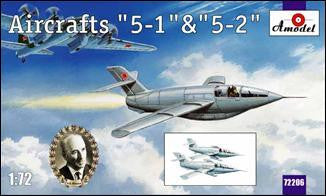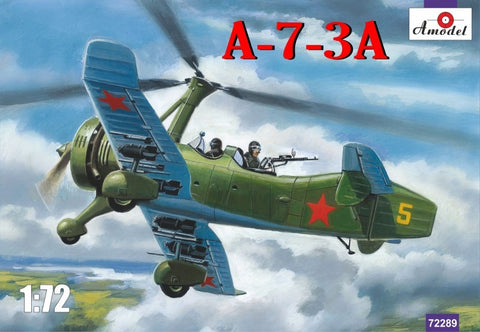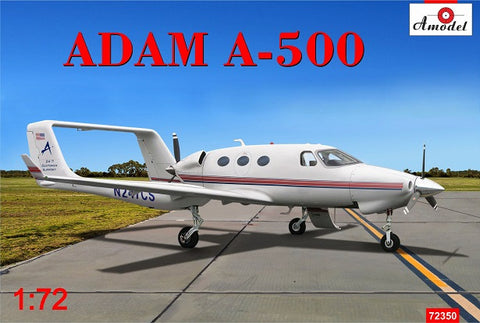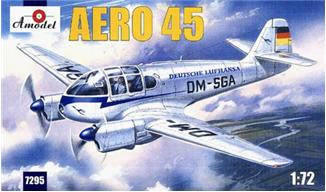
Unimodel Military 1/72 PzKpfw 38(t) Ausf G Light Tank Kit
This Product Usually Ships In 2-3 Business Days
UNM-341DISCONTINUED ITEM - WHILE SUPPLIES LAST
The Panzerkampfwagen 38(t) was originally a Czech tank of pre-World War II design. After Czechoslovakia was taken over by Germany, it was adopted by the German Army, seeing service in the invasions of Poland, France and Russia. Production ended in 1942, when its armament was deemed inadequate. In all, over 1400 were manufactured. The chassis continued to be produced for Marder III (1942-1944) and Hetzer (1944-1945) tank destroyers, turretless assault guns, anti-tank guns and anti-aircraft guns.
The (t) stands for tschechisch, the German word for Czech; the Czechoslovak military designation was LT vz. 38. Manufacturer's designations included TNH series, TNHPS, LTP and LTH. The special vehicle designation for the tank in Germany was Sd. Kfz. 140.The Panzer 38(t) was a conventional pre-World War II tank design, with riveted armor and rear engine. The riveted armor was mostly not sloped, and varied in thickness from 10 mm to 25 mm in most versions. Later models (Ausf. E on) increased this to 50 mm by bolting on an additional 25 mm armor to the front. Side armors received additional 15 mm armor from Ausf. E onward.
The two-man turret was centrally located, and housed the tank's main armament, a 37 mm Skoda A7 gun with 90 rounds stored on board. It was equipped with a 7.92 mm machine gun to the right of the main ordnance. This turret machine gun was in a separate ball mount rather than a fixed coaxial mount. This meant the machine gun could be trained on targets independently. Alternatively, the commander/gunner could couple the machine gun internally to the main gun and use it as a coaxial machine gun. The driver was in the front right of the hull, with the bow machine-gunner seated to the left, manning the 7.92 mm machine gun. As with many 1930s tanks, the bow gunner was also the radio operator. The radio was mounted on the left of the bow gunner.
Minor adjustments, such as adjustable seats for the driver and firmer footing for the commander/gunner and loader, were provided in German service. A total of 2,550 rounds were carried for the bow and turret machine guns. The driver could also fire the hull machine gun with a trigger fitted on the left tiller bar.In 1935, the Czechoslovak tank manufacturer ČKD was looking for a replacement for the LT-35 tank they were jointly producing withŠkoda Works. The LT-35 was complex and had shortcomings, and ČKD felt there would be orders both from the expanding Czechoslovak army and for export.
ČKD decided to use a suspension with four large wheels for their new tank. It resembled the Christie suspension outwardly, but was actually a conventional leaf spring unit. The resulting vehicle was reliable, and an export success: 50 were exported to Iran, 24 each to Peru and Switzerland. Lithuania also ordered some. The British Royal Armored Corps (RAC) had one trial model delivered on March 23, 1939 to Gunnery School at Lulworth. A report stated, the "(bow) gunner could not sit back comfortably as the wireless set was in the way of his left shoulder." The report also stated that due to the shudder while the vehicle was on the move, it was impossible to lay the gun. Even at the speed of 5 mph accuracy was poor. As a result, the RAC did not purchase the Panzer 38(t) and the trial model was returned.
The (t) stands for tschechisch, the German word for Czech; the Czechoslovak military designation was LT vz. 38. Manufacturer's designations included TNH series, TNHPS, LTP and LTH. The special vehicle designation for the tank in Germany was Sd. Kfz. 140.The Panzer 38(t) was a conventional pre-World War II tank design, with riveted armor and rear engine. The riveted armor was mostly not sloped, and varied in thickness from 10 mm to 25 mm in most versions. Later models (Ausf. E on) increased this to 50 mm by bolting on an additional 25 mm armor to the front. Side armors received additional 15 mm armor from Ausf. E onward.
The two-man turret was centrally located, and housed the tank's main armament, a 37 mm Skoda A7 gun with 90 rounds stored on board. It was equipped with a 7.92 mm machine gun to the right of the main ordnance. This turret machine gun was in a separate ball mount rather than a fixed coaxial mount. This meant the machine gun could be trained on targets independently. Alternatively, the commander/gunner could couple the machine gun internally to the main gun and use it as a coaxial machine gun. The driver was in the front right of the hull, with the bow machine-gunner seated to the left, manning the 7.92 mm machine gun. As with many 1930s tanks, the bow gunner was also the radio operator. The radio was mounted on the left of the bow gunner.
Minor adjustments, such as adjustable seats for the driver and firmer footing for the commander/gunner and loader, were provided in German service. A total of 2,550 rounds were carried for the bow and turret machine guns. The driver could also fire the hull machine gun with a trigger fitted on the left tiller bar.In 1935, the Czechoslovak tank manufacturer ČKD was looking for a replacement for the LT-35 tank they were jointly producing withŠkoda Works. The LT-35 was complex and had shortcomings, and ČKD felt there would be orders both from the expanding Czechoslovak army and for export.
ČKD decided to use a suspension with four large wheels for their new tank. It resembled the Christie suspension outwardly, but was actually a conventional leaf spring unit. The resulting vehicle was reliable, and an export success: 50 were exported to Iran, 24 each to Peru and Switzerland. Lithuania also ordered some. The British Royal Armored Corps (RAC) had one trial model delivered on March 23, 1939 to Gunnery School at Lulworth. A report stated, the "(bow) gunner could not sit back comfortably as the wireless set was in the way of his left shoulder." The report also stated that due to the shudder while the vehicle was on the move, it was impossible to lay the gun. Even at the speed of 5 mph accuracy was poor. As a result, the RAC did not purchase the Panzer 38(t) and the trial model was returned.
- 124 parts
- 6 photo-etched parts
- Decals






